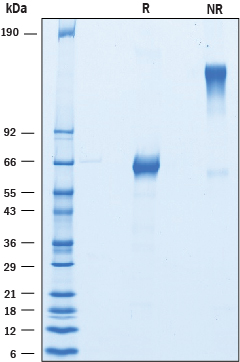Recombinant Cynomolgus/Rhesus Macaque CD27 Fc Protein, CF
Recombinant Cynomolgus/Rhesus Macaque CD27 Fc Protein, CF Summary
Product Specifications
| Cynomolgus Monkey CD27 (Ala20-Arg191) Accession # XP_005569963.1 | IEGRMD | Human IgG1 (Pro100-Lys330) |
| N-terminus | C-terminus | |
Analysis
Product Datasheets
Carrier Free
CF stands for Carrier Free (CF). We typically add Bovine Serum Albumin (BSA) as a carrier protein to our recombinant proteins. Adding a carrier protein enhances protein stability, increases shelf-life, and allows the recombinant protein to be stored at a more dilute concentration. The carrier free version does not contain BSA.
In general, we advise purchasing the recombinant protein with BSA for use in cell or tissue culture, or as an ELISA standard. In contrast, the carrier free protein is recommended for applications, in which the presence of BSA could interfere.
9904-CD
| Formulation | Lyophilized from a 0.2 μm filtered solution in PBS. |
| Reconstitution | Reconstitute at 500 μg/mL in PBS. |
| Shipping | The product is shipped at ambient temperature. Upon receipt, store it immediately at the temperature recommended below. |
| Stability & Storage: |
|
Scientific Data
 View Larger
View Larger
2 μg/lane of Recombinant Cynomolgus Monkey CD27 was resolved with SDS-PAGE under reducing (R) and non-reducing (NR) conditions and visualized by Coomassie® blue staining, showing bands at kDa and kDa, respectively.
Reconstitution Calculator
Background: CD27/TNFRSF7
CD27, also known as TNFRSF7, is an approximately 55 kDa transmembrane protein in the TNF receptor superfamily. It functions as a co‑stimulatory molecule that supports lymphocyte activation and survival (1). Mature human CD27 consists of a 172 amino acid (aa) extracellular domain (ECD) with three TNFR cysteine‑rich repeats, a 21 aa transmembrane segment, and a 48 aa cytoplasmic domain (2). Within the ECD, cynomolgus CD27 shares 94%, 62% and 66% aa sequence identity with human, mouse, and rat CD27, respectively. CD27 is expressed as a disulfide‑linked homodimer that carries N‑linked and O‑linked glycosylation (3, 4). Proteolytic cleavage of CD27 results in the shedding of a 28‑32 kDa fragment of the ECD (4). CD27 is weakly expressed on naïve T cells and NK cells and is up‑regulated upon cell activation (4, 5). It is also up‑regulated on activated germinal center B cells, plasma cells, and a subset of memory B cells (6, 7). CD27 binds to the transmembrane glycoprotein CD27 Ligand/CD70 which is expressed on activated B cells, activated T cells, and dendritic cells (1, 8, 9). This interaction contributes to the activation and survival of CD4+ helper T cells (8‑11), CD8+ effector T cells (12, 13), memory T cells (10), and NK cells (5, 14). Ligation of CD27 on B cells promotes germinal center formation and the expansion and affinity maturation of memory B cell responses (6, 15).
- Nolte, M.A. et al. (2009) Immunol. Rev. 229:216.
- Camerini, D. et al. (1991) J. Immunol. 147:3165.
- van Lier, R.A. et al. (1987) J. Immunol. 139:1589.
- Loenen, W.A. et al. (1992) Eur. J. Immunol. 22:447.
- Takeda, K. et al. (2000) J. Immunol. 164:1741.
- Xiao, Y. et al. (2004) J. Immunol. 172:7432.
- Jung, J. et al. (2000) Eur. J. Immunol. 30:2437.
- Goodwin, R.G. et al. (1993) Cell 73:447.
- Bowman, M.R. et al. (1994) J. Immunol. 152:1756.
- Hendriks, J. et al. (2000) Nat. Immunol. 1:433.
- van Oosterwijk, M.F. et al. (2007) Int. Immunol. 19:713.
- Rowley, T.F. and A. Al Shamkhani (2004) J. Immunol. 172:6039.
- Hendriks, J. et al. (2003) J. Exp. Med. 198:1369.
- Kelly, J.M. et al. (2002) Nat. Immunol. 3:83.
- Raman, V.S. et al. (2003) J. Immunol. 171:5876.
FAQs
No product specific FAQs exist for this product, however you may
View all Proteins and Enzyme FAQsReviews for Recombinant Cynomolgus/Rhesus Macaque CD27 Fc Protein, CF
There are currently no reviews for this product. Be the first to review Recombinant Cynomolgus/Rhesus Macaque CD27 Fc Protein, CF and earn rewards!
Have you used Recombinant Cynomolgus/Rhesus Macaque CD27 Fc Protein, CF?
Submit a review and receive an Amazon gift card.
$25/€18/£15/$25CAN/¥75 Yuan/¥2500 Yen for a review with an image
$10/€7/£6/$10 CAD/¥70 Yuan/¥1110 Yen for a review without an image

